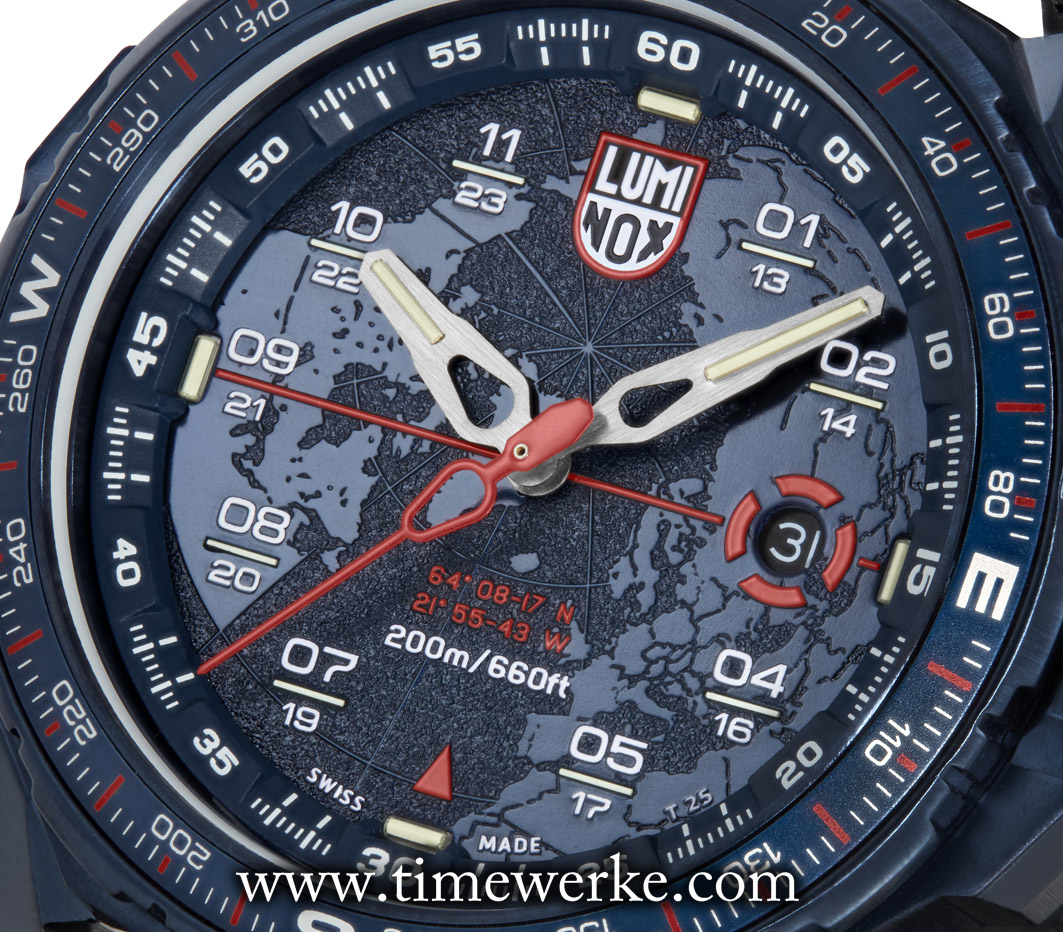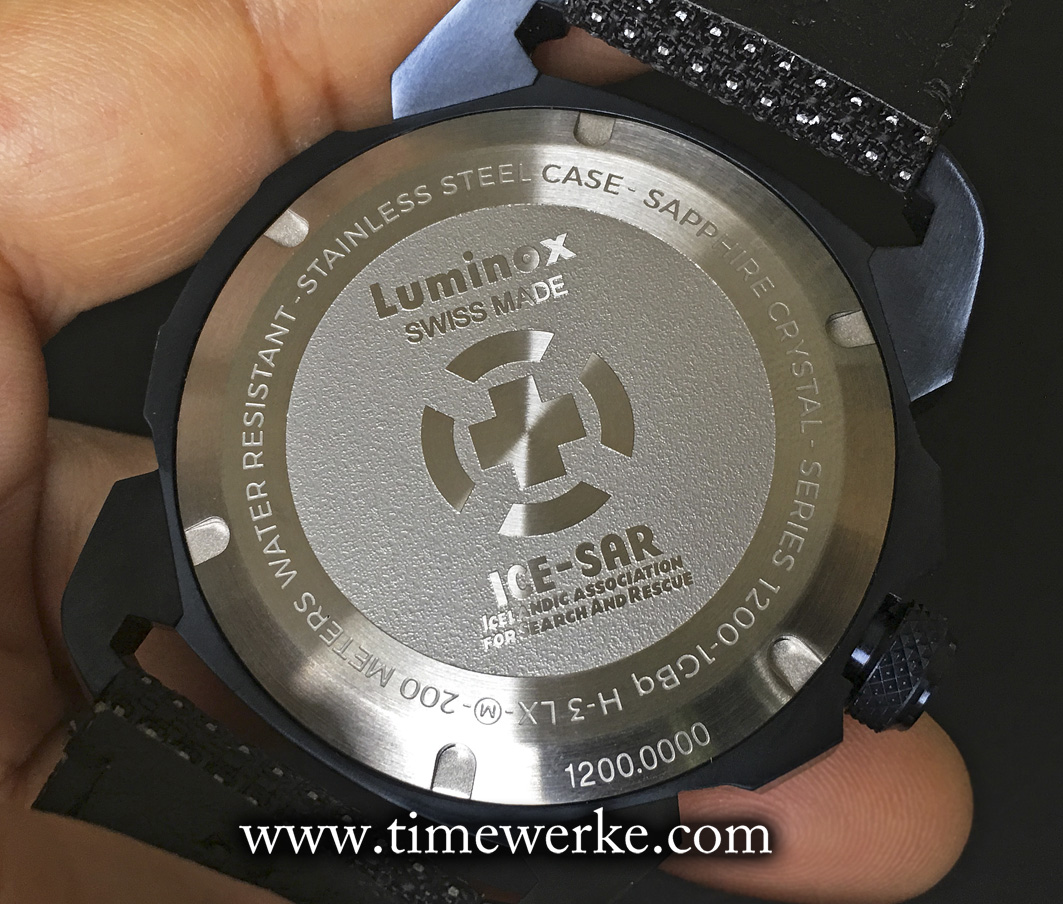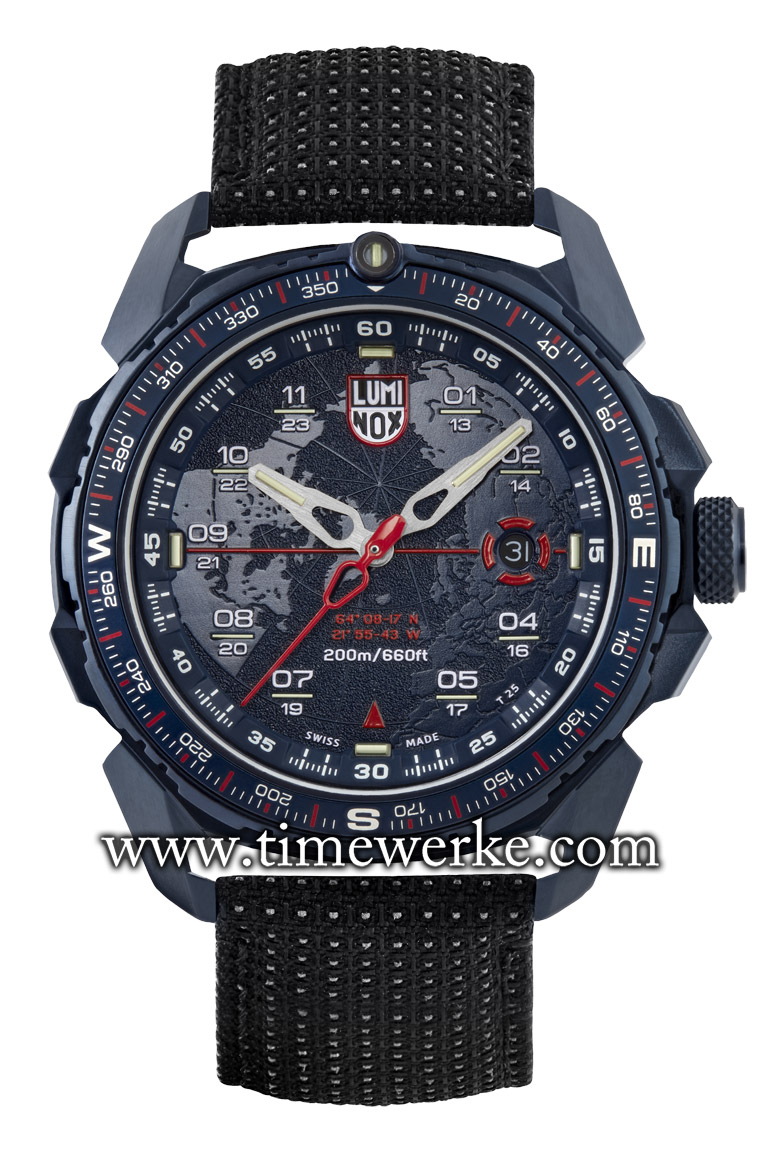
Luminox ICE-SAR Arctic 1200 Series model 1203 with the blue dial. Inscribed in red on the dial: 64° 08-17 N 21° 55-43 W. The circular designs in red surrounding the date aperture are part of the ICE-SAR logo. The dial depicts the map of the Northern Hemisphere as seen top-down and angled from the Arctic perspective. Iceland is the land mass below the central hour, minute and seconds hands. Photo: Luminox.
In 2018, Luminox partnered with the Icelandic Association for Search and Rescue, otherwise known as ICE-SAR, and launched the ICE-SAR Arctic 1000 Series collection comprising five models. The main highlight being the limited edition anniversary piece – the ICE-SAR Arctic 1000 model 1203.SAR as seen in the video below:
Source: TimeWerke Videos on YouTube.
The Luminox x ICE-SAR partnership continued into 2019 with the ICE-SAR Arctic 1200 Series. While the distinctive case shape is retained, one major difference is that the watchcases of the ICE-SAR Arctic 1200 Series are now in stainless steel.
What’s more, there is what is described as a “map of the world” stamped on the dial. Actually, it is more like the map of the Northern hemisphere as seen from the Arctic point of view. From this perspective, one will be able to see the North Pole, Greenland, Canada, Russia and Northern Europe including Iceland.
Iceland is the land mass just below the central hour, minute and seconds hands that are shaped to represent carabiners, an essential tool used by rescuers. Below Iceland, one will spot “64° 08-17 N 21° 55-43 W” inscribed in red on the dial.
What is the significance of: “64° 08-17 N 21° 55-43 W”?
Actually, the more appropriate form, from what we understand, should be: 64°08’17”N, 21°55’43”W. These are geographical coordinates for a specific location in DMS (degrees, minutes and seconds) format at the latitude of 64 degrees (64°), 8 minutes (08’) and 17 seconds (17”) north and the latitude of 21 degrees (21°), 55 minutes (55’) and 43 seconds (43”) west.
In decimal degrees (DD) format, it will be 64.132866 degrees north and -21.918024 degrees west of the Prime Meridian.
What is located here based on the geographical coordinates? Well, if you key in these coordinates into Google Maps, it will lead you to Skógarhlíð 14, 105 Reykjavik in Iceland. This is the headquarters of Slysavarnarfélagið Landsbjörg – the Icelandic Association for Search and Rescue – ICE-SAR.
Having understood this, one can well appreciate the four curved decorations in red surrounding the date aperture as these form part of the ICE-SAR logo which has a cross inside. Speaking of which, the ICE-SAR logo is engraved on the case back of the Arctic 1200 Series models.

The ICE-SAR logo is engraved on the case backs of the Luminox ICE-SAR Arctic 1200 Series. Photo: © TANG Portfolio/TimeWerke.
In addition to the steel case, the ICE-SAR Arctic 1200 Series collection now has a screwed-down crown and a bi-directional rotatable bezel, features that were not part of the Arctic 1000 Series.
With a rotatable bezel, one will be able to use this Arctic 1200 Series as a sun compass. Models in the ICE-SAR 1200 Series are water-resistant to 200 metres or 660 feet.
For those who opt for the strap rather than the steel bracelet, do note that reflective material have been embedded into the textile strap, similar to the reflective material on ICE-SAR uniforms, so we are told.
Source: TimeWerke Videos on Youtube.
Similar to the ICE-SAR Arctic 1000 Series, the 1200 Series have been built to meet the extreme conditions faced by ICE-SAR volunteers who have to deal with volcanic eruptions, avalanches, shipwrecks and major storms.
After all, like its famed watches made for US Navy SEALs, Luminox timepieces are made for the extremes.

Luminox ICE-SAR Arctic 1200 Series model 1203. Priced at SGD1,240 before tax with the textile strap. Photo: Luminox.
Luminox ICE-SAR Arctic 1200 Series
Introduced in 2019
Technical Features:
• Ronda 715 lithium Swiss quartz movement
• Bi-directional turning bezel
• Sapphire crystal with anti-reflective-coating
• Stainless steel screwed-down crown
• Hydraulic stamped dial featuring the map of the world and ICE-SAR Headquarters
• 46mm diameter case in stainless steel
• Water-resistant to 20 atm
• Metal band or reflective textile strap
• Special booklet explaining the Luminox x ICE-SAR partnership
Shown above is the 1203 model that is priced at SGD1,240 with the textile strap.
